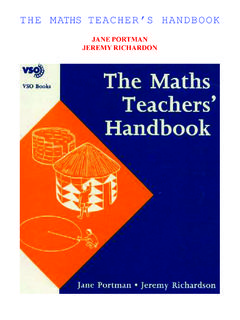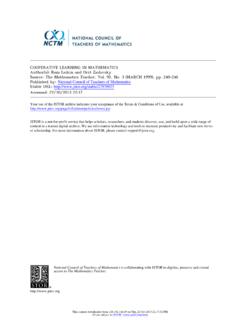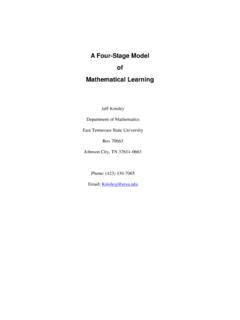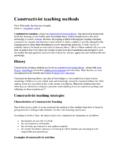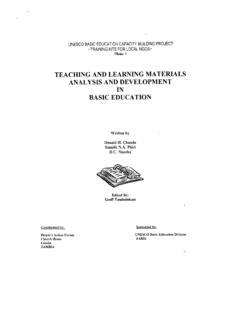Transcription of Problems in Teaching Primary School Mathematics
1 Problems in Teaching Primary School Mathematics Se n Delaney, PhD Marino Institute of Education Laois Education Centre 18 October 2012 Introductions Who here: Teaches junior/senior infants Teaches 1st/2nd class Teaches 3rd/4th class Teaches 5th/6th class Teaches a single class level Teaches two class levels Teaches three or more class levels Teaches in a DEIS School Is a learning support teacher Is a resource teacher Is a principal What s on your mind about Teaching Mathematics ? Language of Mathematics reading Problems can be tough How to make problem solving fun children s faces drop when they re doing the SIGMA (especially children with special needs) Link between Primary School maths and Junior Cert Project Maths what is worth emphasising in senior classes? Recommend any good maths games? Ideas for use of interactive boards in maths class Use of hands-on materials in senior classes when you could have 30+ in the class Creating a maths-friendly environment in the School - changing it Preparing for a WSE in relation to maths Challenging brighter children How will this evening help you?
2 New habits change practice Choose one maths Teaching habit that you can adopt based on this evening s presentation and from discussion before during and after the presentation Plan for Presentation Key element in improving the Teaching of maths My story in Teaching maths An example of Teaching maths to promote children s thinking Teaching maths using Problems Finding and choosing Problems The problem of differentiation in maths class A key element in improving the Teaching of maths is ..NOT ..getting children to think and talk mathematically Encourage Teachers to ask questions such Compare Estimate How does that connect How can you Encourage Teachers to ask questions such Compare Estimate How does that connect How can you How I taught maths Check the children s homework or do a tables or mental maths activity Demonstrate how to do some sample Problems by doing them on the board Ask the children to practise Problems similar to those for which solutions were demonstrated.
3 Give individual help to children who were having difficulties. Correct class work and assign homework Why I began to teach maths differently 2 6 - 1 7 Video If children only learn to memorise, they give up thinking for themselves There are other ways to teach A Review homework or remind children of accomplishments so far Present the topic and Problems for the day Students or teachers develop procedures to solve the problem (s) at the board, taking suggestions from other students and the teacher Practise doing Problems similar to those worked on above B Review the previous lesson with a brief teacher lecture or summary by students Present the problem for the day. One problem only. Students work individually on Problems first and then in groups for 5-10 minutes Students (selected by teacher) present and discuss one or more solution methods. Highlight and summarise major points C Review previous material: Check homework or engage in warm-up activity Demonstrate how to solve Problems for the day by presenting a few sample Problems and demonstrating how to solve them Practise Problems similar to those for which solutions were demonstrated Correct class work and assign homework GERMANY JAPAN UNITED STATES How I try to teach maths now Much more talking about maths in the classroom Children share their ideas with each other Get the children reasoning and justifying their answers Use fewer Problems Use more open-ended Problems Use the Problems to teach a new maths topic, not just to check if the children understand it Sample Open-ended problem Dublin Zoo has just received two new sheep for the Family Farm part of the zoo.
4 The zoo keeper wants to build an enclosure for the sheep. She decides that the enclosure must be square or rectangular with an area of 100 square metres. different configurations could she build? many metres of fencing will she need for each possible design? your copy or some graph paper to draw all the possible rectangular or square designs. a key to tell how much each unit on the grid paper equals. fence would you recommend that the zoo keeper builds? Why? Sample of Teaching Using Problems Video Clip 20 Fifth class children Recruited from 11 different schools (4 DEIS), mostly around Marino area Topic: Area After School on a Friday afternoon in May 2011 Maths Laboratory: Goal is not to offer model Teaching , but public Teaching Observed by 20 educators Amplified and video recorded Link to Video Time-Code 04, from 12 31 01 to 16 56 (or earlier) problem Solving Strategy 1 RUDE Read the problem Underline the key words Draw a diagram of the problem Estimate your answer and then solve the problem problem Solving Strategy 2 STAR Search the word problem (info) Translate the words into an equation or picture (plan) Answer the problem (solve) Review the solution (check)
5 problem Solving Strategy 3 LUV2C Look Underline Visualise Choose Numbers Calculate Teaching Mathematics Using Problems Little evidence that such strategies work Some evidence that classifying Problems into problem -types can be helpful for children with learning disabilities Best way to learn problem solving is to practise solving Problems Skill in problem solving develops slowly over time Many textbooks have too many Problems , and many of the Problems are of poor quality Worked Example in a Textbook from Taiwan From Charalambous et al, 2010 Worked Examples in 2 Textbooks from Ireland From Charalambous et al, 2010 Sources of Problems (Annual subscription necessary) Choosing a problem A good Should leave the solver feeling stuck at first The maths is what makes the problem problematic Relates to the children s experience Connects different maths topics Allows children with different attainment levels to achieve success with it May take time, even days, to complete Requires children to justify and explain their answers and methods The problem of differentiation in Teaching maths Children differ in many ways Within maths (from strand to strand) Within maths skills How they learn Motivation Learning disabilities Giftedness Generic labels, such as weak, bright, lazy, clever, etc.
6 , can disguise children s specific talents and shortcomings Differentiation Strategies Encourage all children to work together to help the class as a whole to learn maths learning maths through talking through ideas Use Problems that children can approach at different levels Sample problem for Differentiation I have 10-cent, 5-cent and 1-cent coins in my money box. If I open the box and take out three coins, how much money could I have? How can you be sure that you have found all the possible amounts? Skills Children Need in Order to Succeed in Maths Conceptual processing ( identifying and extending patterns) Language ( reading a word problem ) Visual-spatial processing ( working with 2-d and 3-d representations) Organisation ( collecting and recording data) Memory ( remembering number facts; remembering the steps of a mathematical procedure) Attention ( focusing on the details in a maths problem ) Psycho-social ( working with a partner or in a group) Fine-motor skills ( drawing geometric figures) (Brodesky, 2002) A child with dyslexia Possible Learner Difficulties Possible Teacher Response Language comprehension impairment Use vocabulary that is familiar to the student Explain new vocabulary carefully Monitor and vary the level of text learners are expected to read in Mathematics Problems Highlight words that have different meanings in different contexts ( third, prime, factor)
7 Counting speed is slower than in other learners Provide more time in tables and other maths tests to allow students to use strategies when they can t recall number facts Memory Problems Give short instructions Recap at end of lesson and revisit topics frequently Monitor early work on new topics carefully so that incorrect strategies are not practised Use concrete materials (including fingers or pictures) Omission of digits and numerals Encourage learners to compare answers with estimates Directional confusion in writing digits and doing algorithms Work on the concepts first and on recording later A Child with dyslexia Possible Learner Strengths Estimation Subitising Place value Possible Learner Difficulties Possible Teacher Response Phonological (speech sounds) processing Exaggerate differences in words that sound similar ( Tens and tenths; hundreds and hundredths; fifteen and fifty) Difficulty with the decimal place Highlight the decimal point possibly by recording it in a different colour Supplementary Material Concrete Materials & Visual Aids Base Ten Materials Geoboards Rulers Hundred Square Addition Table Multiplication Table Base Ten Materials Naming Them Small cubes Longs Flats Large Cubes Uses of Base Ten Materials Estimate how many small cubes on the table Equivalent Representations Demonstrating addition, subtraction and division Introducing Decimals (Re-define the unit)
8 Geoboards Uses of Geoboards Angles Symmetry Percentages Fractions 2-D Shapes Area and perimeter Rulers or Measuring Tapes Uses of Rulers Number lines Measuring Fractions and decimals Addition and Multiplication Number Facts ADDITION NUMBER FACTS IN FIRST CLASS Start with a blank 12x12 grid Show the children how the addition square works by giving some examples 1+ + 0 1 2 3 4 5 6 7 8 9 10 0 1 1 2 2 3 3 4 4 5 5 6 6 7 7 8 8 9 9 10 10 11 Or 6+ + 0 1 2 3 4 5 6 7 8 9 10 0 6 1 7 2 8 3 9 4 10 5 11 6 12 7 13 8 14 9 15 10 16 BUILD UP THE REST OF THE ADDITION SQUARE + 0 1 2 3 4 5 6 7 8 9 10 0 0 1 2 3 4 5 6 7 8 9 10 1 1 2 3 4 5 6 7 8 9 10 11 2 2 3 4 5 6 7 8 9 10 11 12 3 3 4 5 6 7 8 9 10 11 12 13 4 4 5 6 7 8 9 10 11 12 13 14 5 5 6 7 8 9 10 11 12 13 14 15 6 6 7 8 9 10 11 12 13 14 15 16 7 7 8 9 10 11 12 13 14 15 16 17 8 8 9 10 11 12 13 14 15 16 17 18 9 9 10 11 12 13 14 15 16 17 18 19 10 10 11 12 13 14 15 16 17 18 19 20 MAKE THE ADDITION FACTS EASIER BY ELIMINATING THE.
9 COMMUTATIVE PAIRS + 0 1 2 3 4 5 6 7 8 9 10 0 0 1 2 3 4 5 6 7 8 9 10 1 1 2 3 4 5 6 7 8 9 10 11 2 2 3 4 5 6 7 8 9 10 11 12 3 3 4 5 6 7 8 9 10 11 12 13 4 4 5 6 7 8 9 10 11 12 13 14 5 5 6 7 8 9 10 11 12 13 14 15 6 6 7 8 9 10 11 12 13 14 15 16 7 7 8 9 10 11 12 13 14 15 16 17 8 8 9 10 11 12 13 14 15 16 17 18 9 9 10 11 12 13 14 15 16 17 18 19 10 10 11 12 13 14 15 16 17 18 19 20 ..THE +0 FACTS 0+0 1+0 2+0 3+0 4+0 5+0 6+0 7+0 8+0 9+0 10+0 + 0 1 2 3 4 5 6 7 8 9 10 0 0 1 2 3 4 5 6 7 8 9 10 1 1 2 3 4 5 6 7 8 9 10 11 2 2 3 4 5 6 7 8 9 10 11 12 3 3 4 5 6 7 8 9 10 11 12 13 4 4 5 6 7 8 9 10 11 12 13 14 5 5 6 7 8 9 10 11 12 13 14 15 6 6 7 8 9 10 11 12 13 14 15 16 7 7 8 9 10 11 12 13 14 15 16 17 8 8 9 10 11 12 13 14 15 16 17 18 9 9 10 11 12 13 14 15 16 17 18 19 10 10 11 12 13 14 15 16 17 18 19 20 ..THE +1 FACTS 1+1 2+1 3+1 4+1 5+1 6+1 7+1 8+1 9+1 10+1 + 0 1 2 3 4 5 6 7 8 9 10 0 0 1 2 3 4 5 6 7 8 9 10 1 1 2 3 4 5 6 7 8 9 10 11 2 2 3 4 5 6 7 8 9 10 11 12 3 3 4 5 6 7 8 9 10 11 12 13 4 4 5 6 7 8 9 10 11 12 13 14 5 5 6 7 8 9 10 11 12 13 14 15 6 6 7 8 9 10 11 12 13 14 15 16 7 7 8 9 10 11 12 13 14 15 16 17 8 8 9 10 11 12 13 14 15 16 17 18 9 9 10 11 12 13 14 15 16 17 18 19 10 10 11 12 13 14 15 16 17 18 19 20.
10 THE +2 FACTS 2+2 3+2 4+2 5+2 6+2 7+2 8+2 9+2 10+2 + 0 1 2 3 4 5 6 7 8 9 10 0 0 1 2 3 4 5 6 7 8 9 10 1 1 2 3 4 5 6 7 8 9 10 11 2 2 3 4 5 6 7 8 9 10 11 12 3 3 4 5 6 7 8 9 10 11 12 13 4 4 5 6 7 8 9 10 11 12 13 14 5 5 6 7 8 9 10 11 12 13 14 15 6 6 7 8 9 10 11 12 13 14 15 16 7 7 8 9 10 11 12 13 14 15 16 17 8 8 9 10 11 12 13 14 15 16 17 18 9 9 10 11 12 13 14 15 16 17 18 19 10 10 11 12 13 14 15 16 17 18 19 20 + 0 1 2 3 4 5 6 7 8 9 10 0 0 1 2 3 4 5 6 7 8 9 10 1 1 2 3 4 5 6 7 8 9 10 11 2 2 3 4 5 6 7 8 9 10 11 12 3 3 4 5 6 7 8 9 10 11 12 13 4 4 5 6 7 8 9 10 11 12 13 14 5 5 6 7 8 9 10 11 12 13 14 15 6 6 7 8 9 10 11 12 13 14 15 16 7 7 8 9 10 11 12 13 14 15 16 17 8 8 9 10 11 12 13 14 15 16 17 18 9 9 10 11 12 13 14 15 16 17 18 19 10 10 11 12 13 14 15 16 17 18 19 20 ..THE TEN AND FACTS 10+3 10+4 10+5 10+6 10+7 10+8 10+9 10+10 ..THE DOUBLES 3+3 4+4 5+5 6+6 7+7 8+8 9+9 + 0 1 2 3 4 5 6 7 8 9 10 0 0 1 2 3 4 5 6 7 8 9 10 1 1 2 3 4 5 6 7 8 9 10 11 2 2 3 4 5 6 7 8 9 10 11 12 3 3 4 5 6 7 8 9 10 11 12 13 4 4 5 6 7 8 9 10 11 12 13 14 5 5 6 7 8 9 10 11 12 13 14 15 6 6 7 8 9 10 11 12 13 14 15 16 7 7 8 9 10 11 12 13 14 15 16 17 8 8 9 10 11 12 13 14 15 16 17 18 9 9 10 11 12 13 14 15 16 17 18 19 10 10 11 12 13 14 15 16 17 18 19 20.



